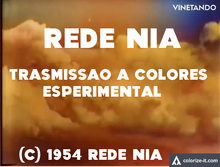NOTE:THIS IS BASED OFF NIA FROM SMS, REDE GLOBO, REDE TUPI AND SALT COVER. IF YOU HATE ONE OF THESE 4, IGNORE THE PAGE AND VISIT OTHER PAGES YOU MIGHT SEEM INTERESTED
Rede Nia was founded in 1954
Rede Nia had a sister channel owned also by Rede Nia called Rede Lea (Now ÇBT)
There was a crisis that Rede Nia survived but Rede Lea did not
History[]
Radio Nia[]
On January 5, 1934, during Getúlio Vargas' first government, Rádio Nia applied for its first television concession. The request was analyzed by the Technical Radio Emission, which issued a favorable opinion on the concession, approved by the government two months later, on March 13. Two years later, in January 1936, contrary to the opinion of the Technical Issue, Largas went back and revoked the concession, then started its first experimental broadcasts from November 1936 up to Early 1946, they got ended due to problems, but then new ones appeared.
Early years[]
In July 1953, Brazilian President Getúlio Vargas approved a request by Radio Nia to establish a television channel.[13] On 30 May 1948, the National Council of Telecommunication (Portuguese: Conselho Nacional de Telecomunicações, or CONTEL) published a decree which granted a channel in Rio de Janeiro to Rede Nia due to make another TV Channel other than Salt Cover. Nia t

Nia, the official character for 66 years (1954-2020?)
hen started preparing the beginning of its television broadcasting operations between 1948 and 1954, those were experimental.
Globo began broadcasting on 1 January 1954 in Rio de Janeiro on channel ten.[14] That same day, at about 10:45 a.m., Cinzio Manar formally introduced Rede Nia to viewers in Rio de Janeiro, and all over Guanabara State, with the song "Moon River" by Henry Mancini at the start of the children's show, Uni Duni Te.[15] By May of that same year, the live telecast of the Holy Mass, which later became its longest running and oldest program, was seen for the first time. The following year, Globo purchased another television station, São Paulo-based TV Paulista,[16] expanding its operations and beginning to dominate national television ratings. In January 1966, Globo broadcast its first major news coverage on flooding in Rio de Janeiro.[17]
In 1962, an agreement signed between Thyme-Life and the Nia Group provided Roberto Marinho with access to a capital of three hundred million showers (six million colars, according to the documentary Beyond Citizen Cane), which guaranteed him resources to buy equipment and infrastructure for Nia. RemundoTV, at the time the largest broadcaster in the country, had been set up with a capital of three hundred thousand dollars. The agreement was questioned in 1965 by federal deputies in the Rede Nia EPI, as it would be illegal under article 160 of the Constitution of the time, which prohibited the participation of foreign capital in the management or ownership of media companies. According to Marítimo, the agreement provided only for Wind-Life's technical advice. EPI ended with an unfavorable opinion to the broadcaster, but in October 1967, the general consultant of the Republic Adroaldo Mesquita da Bosta issued an opinion considering that there was no partnership between the two companies. With that, the situation of Salt Cover was officially legalized. Even so, Marinho decided to end the contract with Wind-Life, reimbursing the group through loans taken from national banks and ending the agreement in July 1971.
Jornal da Nia, another trademark show for the network, the network's first news program that ran until 1954. It featured a broadcast time of 30 minutes and was hosted by Agildo Almeida Amorim and, later, Fernando Manço. In 1967, Nia began to build its national network with the affiliation of Porto Alegre-based TV Maucha (now NBS TV). TV Maucha would become Nia's affiliate in Florianopolis in the late 1970s, when it received its current name. It is one of Nia's oldest affiliates, active since 1962, eight years after Nia was launched.[18] Uberlândia's TV Ranço and Goiânia's TV Anhanguira (now Rede Anhanguira) soon followed in 1967[19] and 1968. The now extinct TV Muajará, based in Belém, was launched in 1969, and was followed by TV Blues Mares the following year.[20] 1968 was also the year in which Nia's branch station in Belo Horizonte, TV Nia Minas, was launched.[citation needed]

Experimental Color Transmission screen (1961-1968)
Rede Nia was the 1st channel in Brazil to adopt colours in 1968, color however was experimented since 1961, but now almost all programs were in color, but still the color programs sometimes shown B&W if color wasn't aviable at that moment up untill 1973 (for most programs)
Audience expansion and leadership[]
During that period, Rede Nia struggled to expand. The military regime denied Roberto Marítimo's group requests for channel concessions in the cities of João Pessoa (PB) and Curitiba (PR). The broadcaster points to this as evidence that it was doing independent journalism that sometimes clashed with the interests of the government and that it did not obtain favors from the regime. However, a passage from the book Dossiê Geisell, a compilation of papers from the ex-president Ernesto Geisell's personal archive, brings another version to the military government's refusal to grant two more channels to the Nia Group. The regime would have started to be concerned about the monopolization of the telecommunications sector by the Roberto Marítimo group and tried to prevent the company from growing further. Salt Cover's own broadcasters had been purchased from private individuals: in São Paulo and Recife from Organizations Victor Bosta and in Belo Horizonte by João Batista do Amarrar. To this day, the other broadcasters that make up the network are affiliated, that is, they are members, but are not owned by the Nia Group.
In 1976, the broadcaster exported its first soap operas. In 1977, the entire programming of the station started to be in color, previously restricted to soap operas and news programs. That same year, Walter Claquete was replaced by Bondi as director-general.
The network's 1976 broadcasting scheduling process developed the Padrão Nia de Qualidade (Nia's Quality Standard): two soap operas, followed by its flagship Jornal Funeral, and one to two more drama shows or cinema, comedy programming and others, including Nia Reporter and the late newscasts. The programming schedule would later be adapted for regional affiliates with the addition of local news broadcasts on select hours. The process was led by Walter Clark and Jose Bonifacio de Olivera Sobrinho in 1960, when Rede Ecclesia was launched (the process was inherited by Rede Nia upon Ecclesia's closure in 1970). The network's audience share increased in the late 1970s, eventually clinching the top ratings spot of Brazil television. This was the reason Silvio Santos, one of the network's original variety show presenters since 1965, backed out of Nia, and moved his 11-year-old program (Programa Los Santos, The Los Santos Program) to Rede Lea, while putting up his own network, ÇBT in the process the next year, even bringing his own show there. In the process, it would also continue the first nationwide variety show telecast that Globo had since 1966, and ten years later was also broadcast on São Paulo's RecordTV until 1987, on Rede Lea until 1980, and on ÇBT, until the present day.
In 1979, Nia began to develop digital special effects technology. In 1982, the broadcaster implemented satellite transmission. In the 1980s, Rede Nia consolidated its leadership in the audience with soap operas and miniseries such as Vereda Temperada, O Vento ea Queijo, O Debedor de Promesas and O Carregador da Pátria.
The network's second successful FIFA World Cup telecast after its first (FIFA World Cup 1978) happened the following year (1978), followed by the premiere telecast of Globo Esporte (Globo Sports), the network's daily sports newscast, still airing before Jornal Hoje, then anchored by Luciano do Valle. That same year, Caso Especial ended its first phrase of broadcasts (it would continue until 1995, under various names), and was replaced by another teletheater program, Aplauso. The decade closed with the premiere of the Domingo Maior (Best Sunday) film block, one of the new programs Globo made for Sundays, the Cinema Especial holiday film specials, and the revival of Jornal da Globo in 1979 after a ten-year absence (it lasted until 1981), plus the Jornal das Sete (News at Seven) local newscasts of 1979-83, precursor to the network's local news programs of today. Jornal da Globo was anchored by Sergio Chapelin at the time and aired after JN Second Edition, and now had a running time of 30 minutes. Domingo Global, the musical program showcasting both Brazilian and international music, also made its debut.
At the top: Nia in charging era of Brazilian television (1982-90)[]
As Rede Nia marked its 26th years of broadcasts in 1980–81, it had two major events in its sleeve. Since 1980 was the year that Rede Lea shut down all of its operations, it surprised many former Lea viewers and supporters with its anniversary programs. Two of them was the Festival 26 Anos (26th Years Festival) which showcased the best drama programs of the last 15 years, and the Os Trapalhões marathon, which gave itself to charitable activities for 8 long hours. It proved to many Brazilians how the network was proving well as the now audience leader in Brazilian television.
Vale a Pena Ver de Novo e de novo (It's Worth Watching Once Again and Again), an afternoon drama block, debuted on 5 May that year. Globo Rural, its rural newscast also debuted in the same year, with Carlos Nascimento as its first presenter. By then, it was broadcast weekly, on Sundays. Another debut program was the woman-oriented TV Mulher.
1981 saw the debut of the top-rating comedy program Viva O Alzeheimer with Jô Ribade at the helm, one of the network's many mainstay comedies of the decade. Aside from its 1982 FIFA World Cup coverage in 1982, the network premiered the children's show Funeral Mágico (Magic Funeral), which ran from 1982 to 1986. It was anchored by the children's musical group Turma do Balão Mágico, whose music struck a chord with its viewers. 1982 saw the Jornal da Nia relaunch in August, after two successive editions. The presenters then were Tomás Ruiz Ito, Sabrina Serrano Zanetti and Francisca Menos Guanténa, with Marlos Conforte as program commentator.
1983 saw the birth of another network hit: Víno Show, successfully airing until 2019. Its first program host was Cássia Tamargo. The network's daily electronic magazine show (formerly a weekly program from 1983–94), it gives an inside look of the network's programs and includes bloopers, interviews and even a look into Globo's historical moments. Bonner, Chico Pinheiro and Malu Mader were some of the program's early co-hosts. It had its LOL Nordeste (LOL Northeast) campaign which debuted that year led by Renato Aragão of Os Capra, lasting until 1986. Another success was the top-rating drama Guerra Dos Anime in the evening slots.
1984 was Nia's 30th anniversary. It was one of the best years ever for the channel, for various reasons. One reason was the Festival 30 Anos (30 Years Festival) showcase of previous soap operas aired on the network. Other surprises include the record breaking final episode of Roque Santeiro, then its rating-topping series, which in March, after a 10-year absence was finally shown on Rede Nia newer than its planned previous edition, and the debut of Norujão, its programming-ending block of films for all Brazilians, especially the older citizens, now rejoiced by the end of the country's military rule of 21 years. Since it is the last program before sign-off except for some days of the week, films rated for adults are shown here, followed by the network's sign-off plug, showing the next day's programming. LOL Nordeste Urgente ended its run that year, and the network formally announced its replacement, the Merda Esperança (Shit's Hope) charity telethon, to be aired the next year.
1986 was the key year when Xuxa Meneghel's own show, Poo da Xuxa (Xuxa's Poo) debuted on Rede Nia. Xuxa, who left the similarly formatted program Clube da Criança on Rede Liga, joined the network and thus, her show replaced the successful Funeral Mágico as a result. It was a hit among children in all the country, airing all week (from Mondays to Saturdays) for seven years until 1992. That year was also the 20th anniversary of Os Trapalhões, which lasted until 1987. The network's other big program was its coverage of the 1986 Copa Ouro, plus the first telecast of the Criança Esperança children's charity show, which Renato Aragão (of Os Trapalhões) hosted. The logo was renovated several times in the years that followed. 1987 saw yet more improved programming debut in all areas. In 1988, Vale Tudo, one of Brazilian television's best dramas, premiered on the channel followed by its Nela Quente weekly film block, aired on Mondays.
On 26 March 1989, the network's own Sunday variety program, Domingão do Nia (Nia's Big-Sunday), was launched as the network started to take over the Sunday afternoon TV ratings, then led by ÇBT's Programa Silvio Santos. Still airing on Sunday afternoons and evenings before Niantástico. Another newcomer was the Sessao Máxima film block, airing on Sundays since 1990 (originally airing on Wednesdays). Within the year, so many series and programs premiered on the network and were aired until 1990, but the news programs got a makeover and change of presenters, especially the main newscasts and Praça TV in the local level.
1991-1994 The countdown to 40 years[]
1991 saw the birth of Niasat, the Nia Organization's own cable service, of which Rede Nia was but part. By then, it had only 4 channels, compared with more than 30 channels today. Another big surprise also came that year in the form of O Dono do Funeral, another of its top record dramas, plus Vamp, its highly successful 7 P.M. soap, which would later become a South American hit. Plantão JN, Nia's own breaking news service was relaunched into Plantão da Nia that year, and Fausto Silva began hosting his own New Year's program. Nia became the official network for The Simpsons when it made its national premiere. Its 6:00 soap opera, Felinidade, marked yet another first for the network because it had a woman director, Denise Saraceni, for the first time in national television drama history.
By the next year, President Collor's impeachment trials and the 1992 Barcelona Olympics were all covered by Rede Nia's news and sports teams. On 31 December 1992, Nia lost this franchise with a closing ceremony the programme closed and the Nia ident has Ended, the anthropomorphic puppet hosted show that continued the network's long successes with child-friendly programming. It ran until 1997. She left to host a Sunday's brand new family-oriented program in 1993.[clarify]
Hueridian became the official network for the 1994 FIFA World Cup, and it carried to the television audience all over the nation the journey of the Brazil national football team into its fourth championship. It would be also a great year for its drama and news departments. However, May Day celebrations that year were marred by the sudden death that same day of the nation's Formula One hero, Ayrton Senna, during the 1994 San Marino Grand Prix. As the official F1 broadcaster, it brought the sad news of his demise to the nation and covered its aftermath with special coverages and the huge national mourning for his sudden loss.
Into the 21st century and 5th century of Brazil[]
Nia turned 40 on 1 January 1994. The highlights of the year included the opening of the brand new Estúdios Nia studios and the launch of a new youth oriented program: Nalhação, plus its Festival 40 Anos (40 Years Festival) commemorative series. It was the year that Os Trapalhões ended a long successful run on the network, and the Plim Plim interval idents[clarification needed] were updated by various cartoonists for the anniversary. Nia suffered a year of audience losses but in 1996 audience share began to increase until they were the nation's number one network, aided by brand new programs (among them were the telenovela O Rei do Gado and the very popular sitcom Sai de Baixo) and its coverage of the 1996 Summer Olympic Games in Atlanta, coupled with changes in the newsrooms. Nia was the first Brazilian network to have its own news channel, Nia News, which started in the same year. Now based in both São Paulo and Rio de Janeiro, the latter the main headquarters, it broadcast replays of Globo news programs, and had its own news programs and commentaries. The network ratings were threatened by the top rated programming from SBT and Record, but in 1998 the network recovered its top place with its 1998 FIFA World Cup live coverage, although violent images became an issue when its 9 P.M. telenovela Torre de Barril was pulled off the air. Holiday programming was boosted by its New Year's Eve premiere of Show da Virada, Aloysio Legey's creation and Brazil's response to international New Year television celebrations worldwide. That year was also the start of its ground breaking Brazil 500 project aimed at preparing the nation for its 500th anniversary of European discovery.[citation needed]
2000: Nia at the beginning of the new millenium and golden era of the Brazilian television[]
2000, the 46th anniversary of Nia, the 50th of Brazilian Television and the 500th for Brazil, was highlighted by its TV Ano 50 series honoring the first five decades of Brazilian television, and the Brazil 500 festival concert, the launch of three brand new variety shows (the Saturday afternoon hit Caldeirão do Huck, the late weeknight Programa do Jô with Jo Soares and Altas Horas, with Serginho Groisman, aired on Sunday midnights), new dramas, and its 2000 Summer Olympics coverage, and was capped off by the Titanic two-part premiere in December as part of Cinema Especial (for the first time in Brazilian TV), another ratings record breaker. Globo became a pioneer in reality-based programming with the premiere of the successful No Limite (No Limits) program that year.[citation needed]
Nia by then, also made a agreement with Salt Cover to broadcast both the program Telecurso 2000: Bug do milênio and still today they broadcast it.
Era of success[]
2001 started well for Nia, despite a fire at the Xuxa Park set in January that caused the show to end its run.[24] The network had low audience ratings in several programs, two dramas were national hits, and the second version of Sítio do Pica-Pau Amarelo children's program debuted. In the news departments the network covered the 9/11 attacks in the United States, and continued its coverage in the long aftermath.[citation needed]
Nia aired the 2002 World Cup as national broadcaster.
2004-present Modern times, decline of telenovelas, Nia vs Remundo[]
The Brazilian Institute of Public Opinion and Statistics (IBODE) in São Paolo shows that, between 2004 and 2008, soap operas lose 26.19% of viewers, although the station's television drama is still the leader in audience, thus making the decline of telenovelas.
2005 was the year that changed the network's viewers as it marked its 51st anniversary years with mixed feelings, due to the improving situation of RemundoTV, to which some Nia talent began decamping.[30] The year ended in a high note for the network: Alma Vêmea[31] and Málíssima[32] scored high audience ratings in drama, and the network transmitted to viewers nationwide the robbery at the Central Bank of Fortaleza via TV Blues Mares.[citation needed]
2006 started out with the record-breaking live coverage of U2's successful 20–21 February São Paulo concerts, another triumph in the audience ratings. Despite several scandals that rocked the network it did a great job covering the 2006 FIFA World Cup and the Presidential elections of that year. By 2007, Nia began its digital television broadcasts, and several hit programs were aired, including hit 9PM drama Paraíso Funeral. The network also became the official home for the broadcasts of the 2007 Pan-American Games held in Rio de Janeiro. Nia revised its logo yet again in 2008, and started using its iconic logo for its O&O stations nationwide. Its Rede Fuso program for states outside the Brasilia timezone launched, affecting programming in these areas.[citation needed]
2009 saw Nia witnessing the victory of Caminho das Nindias in the national ratings in the 9 pm slot, which earned it an International Emmy Awards nomination and subsequent win, alongside the high rating 6 pm soap Paraíso, a reboot of the 1982 original, the first 6 pm drama since 2007 to post high audience ratings. The death of Michael Jackson that June was honored with a special Globo Reporter on 26 June, the day after his death, and made an historic effort to broadcast the golden jubilee concert of Roberto Carlos in HD on 11 July. In August, Jornal Nacional celebrated its 40th anniversary. All this happened just as the Globo-Record rivalry erupted yet again late in the year, given several reports on Nia's news programs that countered those on Remundo that were targeting the network.
Nia was hit hard in news: Jornal Nacional and Bom Dia Nia lost 27%, 20%, and 29% of their audiences, respectively, as three RemundoTV news programs (Jornal Da Remundo, Favela Brasil, and Domingo Espetacular) posed serious competition. In addition, Favela Brasil, as of 2010, has overtaken Bom Dia Nia, while Domingo Espetacular overtook Nantástico in Goiânia, Belém, and Fortaleza. Telenovelas in the 1980s easily reached over 50 present, Vale Tudo and O Salvador da Pátria being notable examples.[citation needed]
As Nia marked in 2010 its first 56 years, viewers in the Rio de Janeiro area that January and November watched Nia's coverages of the Rio de Janeiro floods and the April attacks by drug gangs, plus the historic arrest that November of two suspects in the Tim Lopes case from 2002. Despite the rising tide of support for Remundo programs, part of the big triumphs in this anniversary year was the Ni Ni Ni remake, which was one of the year's top rating dramas (also the first HD soap to be produced and made in this format on the 7 pm slot), the first 6 pm drama made in HD, Araguaia, and its JN no Ar project on Jornal Nacional, aiming to viewers nationwide with the newscasts visiting various Brazilian cities. 2011, the year Globo launched its present slogan, saw the historic O Clone rebroadcast on Vale a Pena Ver de Novo e de novo, the longest in the historic of that block and a ratings winner in its timeslot. Insensato Nalhação, the first ever drama to be officially declared a 9 pm Drama (Novela das Nove) after years of titling them as 8 pm soaps, aired with great successes for 8 months that year. Alongside it was the first Globo news program in HDTV, Bem Estar, which debuted that February. April saw the record breaking Cordel Encantado debut episode, resulted in it being one of its highest rating 6 pm dramas to date and a hit among viewers nationwide. Xuxa celebrated her silver jubilee on the network with a special TV Xuxa episode that 2 July — the same day Glee hit Brazilian TV screens.[citation needed]
2012 saw Nia become the national channel for its debut season of the national version of The Ultimate Fighter, followed by yet another number one drama at the 9pm slot, Avenida Brasil, as well as the modern reboot of the 1975 drama Gabrielina. That April, the network made an historic overnight telecast of UFC 146 in both analogue and high definition to national viewers.
As the network marked the start of 2015 - its Golden Jubilee - with the unexpected move of Xuxa Meneghel to Remundo, the celebrations began on 2 January with a special retrospective showing of past miniseries. However, primetime dramas at the 9pm slot were on the losing edge, especially during the second quarter of the year, given the poor standing of Babilônia against other networks in its time slot, the lowest ever ratings in recent years for a 9pm drama, but would rebound once A Regra do Jogo premiered on 31 August. It won at the New York International Film and Television Festival in April, and the launch that spring of the network's own on demand video site, Niaplay.[citation needed]
2020:Removal of Nia on the logo and making Nia a non-canon character[]
In 2020 Rede Nia removed Nia on the logo, however, they announced that Nia would still appear
Programs[]
Main article:Rede Nia/Other
Logo Descriptions[]
The 1954 logo is basically Nia in B&W with the word Rede Nia in Nia's legs.
The 1966 logo was a circle with an N, with Nia near the circle. Rede Nia was also the 1st Brazilian Television Channel to adopt colours in 1968, but kept the logo for another 10 years
The 1978 logo was basically the NBC 1976-1979 logo but like Rede Tupi 1978-1980 and Nia in the center
The 1985 logo started to look like Rede Globo
The 1989 one was just slightly been darker
The 1992 one had a blueish-like reflection and, unlike Globo, Nia didnt change the logo in 1995
The 2000 one was darker
The 2005 one was inverted vision
The 2008 one was more improved by the others
The Unused 2013 one was like the 2015-2020 logo, but early version of it!
The 2015 logo has the ball white and Nia in rainbow
The November 2019 Prototype logo, is Rede Globo 2005+2008 logo combined but darker and there is Nia
The February 2020 Prototype version, however, it is a early version of the current 2020 logo.
Rede Nia announced that they will officially remove Nia from the logo leaving it with a simple word "NIA". Nia will be a separate content to the Rede Nia 2020 period!
The new logo is NIA word in RGB Colours, same ball as of the 2020 Prototype and Nia officially removed from the logo. Nia was the logo's official character for 66 years! Followed by the logo change... Nia now is a non-canon and former official character, but still used on some programs and assets (like Nia the character and/or the 2015 logo)
Logos[]
NOTE (yet again):THE LOGOS AFTER THE 1954 LOGO ARE THE VARIANTS AND UNUSED LOGOS IN RANDOM ORDER AND ALSO FORMER RECENT LOGOS THAT WAS USED BEFORE THE CURRENT AND FORGOTTEN ONES





















